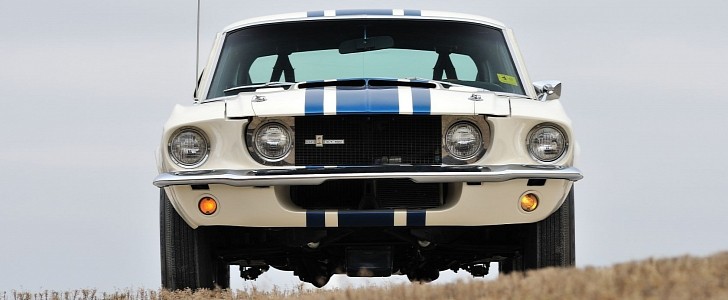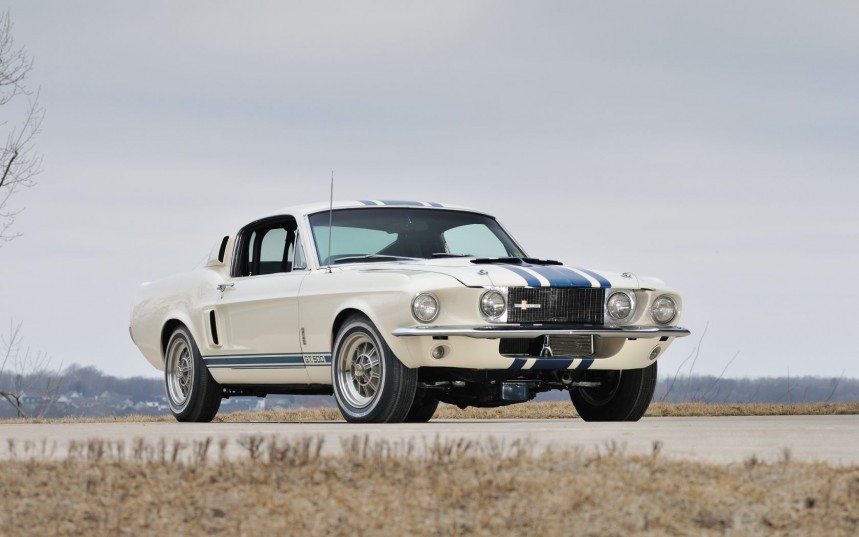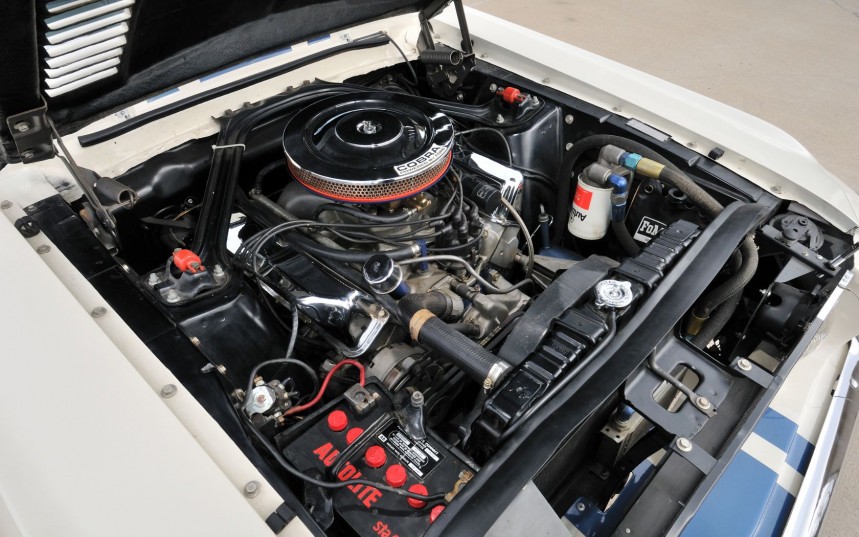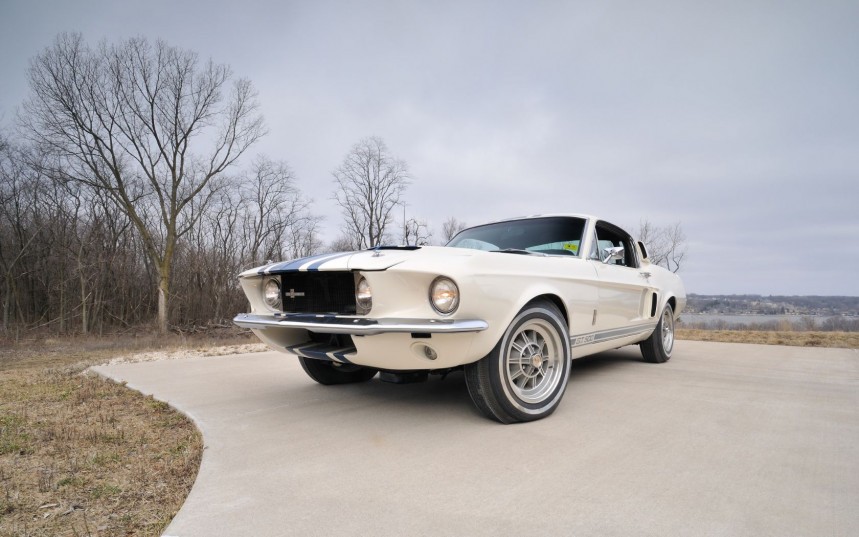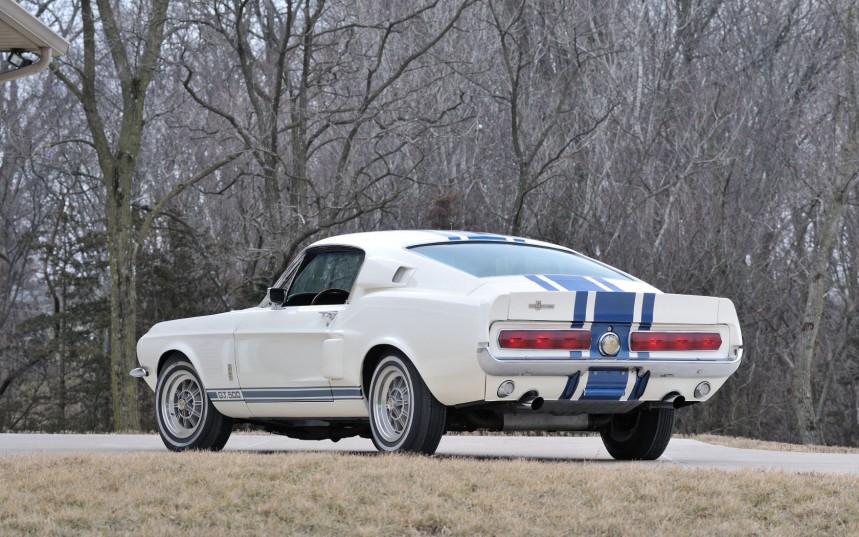Our Mustang Month continues with the story of the legendary 1967 GT500 Super Snake. Born out of the outrageous idea of fitting a Le Mans-winning GT40 engine into a pony car, it has become one of the most iconic vehicles ever built by the legendary Carroll Shelby.
In 1967, to celebrate winning the 24 Hours of Le Mans race a year earlier, Carroll Shelby and his partners at Ford unleashed the most impressive Mustang they had ever built, the formidable GT500.
Powered by a heavily modified 427 cu in (7.0-liter) Police Interceptor engine rated at 355 hp, it was all muscle and no compromise, captivating the hearts of enthusiasts across the country.
While the partnership with Ford is legendary, few people know that Carroll Shelby was also the official West Coast distributor for Goodyear tires during that period.
In February, the company asked him to take part in a promotional event for the new Thunderbolt line of economy tires at Goodyear’s high-speed test facility near San Angelo, Texas.
Obviously, he thought it would be a great opportunity to also promote the new GT500. Legend has it that he talked about the event with former Shelby American sales manager Don McCain who came up with a crazy idea. Jokingly or not, he suggested that a GT500 with a GT40 race engine would be a heck of a marketing stunt.
As mad as that idea was, Shelby was intrigued and eventually decided to make it happen. He gave the task to chief engineer Fred Goodell who immediately got to work.
He selected a white GT500 with the serial number 67402F4A00544, which was stripped down and modified extensively. Inside the engine bay, he fitted a lightweight 427 racing V8 that was virtually identical to the one used in the Le Mans-winning GT40 Mk II. It had aluminum heads, Le Mans conrods, a forged crank, and an aluminum water pump. Additionally, they installed a variation of the race car’s exhaust system, as well as an external oil cooler, a remote oil filter, and an enhanced cooling system.
At the time, it was reported that the engine made around 650 hp. This has since been disputed with many speculating that the actual output was 520 hp. Still, both figures were astonishing 54 years ago and pretty impressive even today.
The race-bred powerplant may have been the most important upgrade the car received, but it wasn’t the only one. To counteract the high-speed cornering forces that the car would endure on the 5-mile oval track, stiffer springs and shocks were mounted on the passenger side. Goodell didn’t stop there and fitted traction bars along with a Detroit Locker differential to make sure that torque was properly applied to the wheels. The front brakes were also swapped with heavy-duty variants that used braided lines.
For the finishing touches, the Super Snake got bespoke chrome headlight ornaments and a custom version of the production Le Mans striping that distinguished it from all other GT500s.
In preparation for the event, its 10-spoke aluminum wheels were fitted with 7.75-15 Goodyear Thunderbolt Whitewalls. These new tires were developed as an affordable option for everyday cars, so they looked out of place on the Super Snake.
Hours before the main event took place, Carroll Shelby drove the rabid pony car around the oval track for a few laps, reportedly reaching speeds of about 170 mph (273 kph).
Since the official test was 500 miles (804 km) long, he passed the helmet to Fred Goodell saying that he had to leave. The latter successfully completed the run with the skinniest tires ever fitted on a GT500 performing flawlessly. He later revealed that the tires were inflated with nitrogen to increase sidewall rigidity and protect them from overheating.
After the team got back to California, the Super Snake was sent to Mel Burns Ford dealership where Don McCain was working. He was sure it would generate enough interest to justify a limited production run and spent the next few months finding potential buyers.
While it drew a lot of attention, it was more expensive than two standard GT500s or a Ferrari 275 GTS/4 NART Spyder and nobody was willing to pay that much. Eventually, McCain acknowledged that a limited production run just didn’t make sense.
Ultimately, it was sold and changed owners several times until came into the possession of Richard Ellis, a rare Mustang collector from Illinois. Although the car was in an exceptional state and only registered 26,000 miles (41,843 km) on the odometer, it was missing some of its original parts.
Ellis replaced some improvised wires and hoses with original components, added a period-correct Rotunda fire extinguisher that was missing, and NOS Shelby 10-spoke wheels, identical to the ones originally mounted. Amazingly enough, he also obtained the only surviving set of brand-new 7.75-15 Thunderbolt whitewall tires.
Even though it belongs in a museum where it could be enjoyed by everyone, the unique high-performance car was offered at an auction in 2019, fetching $2.2 million and becoming one of the most expensive Mustangs ever sold.
The 1967 Shelby GT500 Super Snake is so audacious that it reached legendary status without ever competing in a race. It’s the epitome of an eccentric idea that only the brilliant Carroll Shelby could turn into reality and we’ll forever be grateful to him for building it.
Powered by a heavily modified 427 cu in (7.0-liter) Police Interceptor engine rated at 355 hp, it was all muscle and no compromise, captivating the hearts of enthusiasts across the country.
While the partnership with Ford is legendary, few people know that Carroll Shelby was also the official West Coast distributor for Goodyear tires during that period.
In February, the company asked him to take part in a promotional event for the new Thunderbolt line of economy tires at Goodyear’s high-speed test facility near San Angelo, Texas.
Obviously, he thought it would be a great opportunity to also promote the new GT500. Legend has it that he talked about the event with former Shelby American sales manager Don McCain who came up with a crazy idea. Jokingly or not, he suggested that a GT500 with a GT40 race engine would be a heck of a marketing stunt.
He selected a white GT500 with the serial number 67402F4A00544, which was stripped down and modified extensively. Inside the engine bay, he fitted a lightweight 427 racing V8 that was virtually identical to the one used in the Le Mans-winning GT40 Mk II. It had aluminum heads, Le Mans conrods, a forged crank, and an aluminum water pump. Additionally, they installed a variation of the race car’s exhaust system, as well as an external oil cooler, a remote oil filter, and an enhanced cooling system.
At the time, it was reported that the engine made around 650 hp. This has since been disputed with many speculating that the actual output was 520 hp. Still, both figures were astonishing 54 years ago and pretty impressive even today.
For the finishing touches, the Super Snake got bespoke chrome headlight ornaments and a custom version of the production Le Mans striping that distinguished it from all other GT500s.
In preparation for the event, its 10-spoke aluminum wheels were fitted with 7.75-15 Goodyear Thunderbolt Whitewalls. These new tires were developed as an affordable option for everyday cars, so they looked out of place on the Super Snake.
Since the official test was 500 miles (804 km) long, he passed the helmet to Fred Goodell saying that he had to leave. The latter successfully completed the run with the skinniest tires ever fitted on a GT500 performing flawlessly. He later revealed that the tires were inflated with nitrogen to increase sidewall rigidity and protect them from overheating.
After the team got back to California, the Super Snake was sent to Mel Burns Ford dealership where Don McCain was working. He was sure it would generate enough interest to justify a limited production run and spent the next few months finding potential buyers.
Ultimately, it was sold and changed owners several times until came into the possession of Richard Ellis, a rare Mustang collector from Illinois. Although the car was in an exceptional state and only registered 26,000 miles (41,843 km) on the odometer, it was missing some of its original parts.
Ellis replaced some improvised wires and hoses with original components, added a period-correct Rotunda fire extinguisher that was missing, and NOS Shelby 10-spoke wheels, identical to the ones originally mounted. Amazingly enough, he also obtained the only surviving set of brand-new 7.75-15 Thunderbolt whitewall tires.
Even though it belongs in a museum where it could be enjoyed by everyone, the unique high-performance car was offered at an auction in 2019, fetching $2.2 million and becoming one of the most expensive Mustangs ever sold.
The 1967 Shelby GT500 Super Snake is so audacious that it reached legendary status without ever competing in a race. It’s the epitome of an eccentric idea that only the brilliant Carroll Shelby could turn into reality and we’ll forever be grateful to him for building it.
